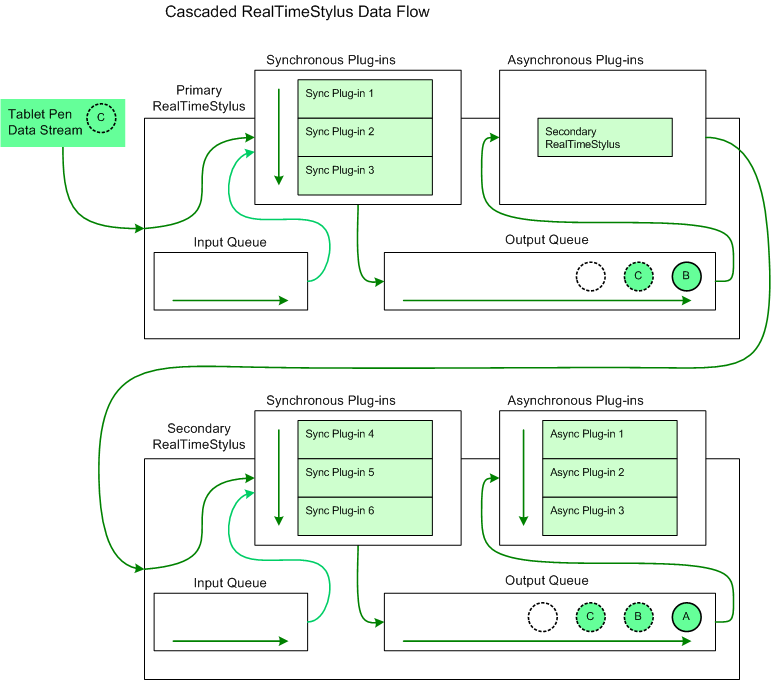The Cascaded RealTimeStylus Model
The cascaded RealTimeStylus model enables you to use two RealTimeStylus objects, each running on a different thread. With this model, you attach a secondary RealTimeStylus object to a primary RealTimeStylus object. The secondary RealTimeStylus object is attached as the only asynchronous plug-in in the primary RealTimeStylus object's asynchronous plug-in collection.
The cascaded RealTimeStylus model may be useful in the following scenarios.
- You can add certain tasks that may be computationally demanding yet still require real-time access to the tablet pen's data stream, such as multistroke gesture recognition, to the secondary RealTimeStylus object's synchronous plug-in collection.
- You can spread the computational load of your synchronous plug-ins over two threads, reducing delays in ink collection on some Tablet PCs.
The following diagram illustrates the flow of tablet pen data through two cascaded RealTimeStylus objects and their plug-in collections.

In this diagram the circle lettered "A" represents tablet pen data that has already been processed by both the primary and secondary RealTimeStylus objects and has been placed on the secondary RealTimeStylus object's output queue. The circle lettered "B" represents tablet pen data that has already been processed by the primary RealTimeStylus object and added to the primary RealTimeStylus object's output queue and has not yet been sent to the secondary RealTimeStylus object. The circle lettered "C" represents the tablet pen data that the primary RealTimeStylus object is currently processing. It is sent to the synchronous plug-in collection and placed on the output queue. The empty circle represents the position in the output queue where future tablet pen data is added.
Constraints
If you use the default RealTimeStylus constructor, you create a RealTimeStylus object that can only accept input from another RealTimeStylus object.
The following list describes the constraints associated with using the cascaded RealTimeStylus model.
- Only two RealTimeStylus objects may be used, a primary RealTimeStylus object and a secondary RealTimeStylus object.
- The primary RealTimeStylus object must be created with a constructor that uses the attachedControl or handle parameter. The secondary RealTimeStylus object must be created with the no-argument constructor.
- The secondary RealTimeStylus object must be the only asynchronous plug-in in the primary RealTimeStylus object's asynchronous plug-in collection.
- A secondary RealTimeStylus object can only be attached to one primary RealTimeStylus object at a time. If it is added to a second primary RealTimeStylus object, the Add method throws an exception, and the secondary RealTimeStylus object is not attached to the second primary RealTimeStylus object.
- The behavior of some of the secondary RealTimeStylus object's members is modified. The following table describes the modified behavior of these members.
| Member | Behavior |
|---|---|
| GetDesiredPacketDescription | This method returns the information from the primary RealTimeStylus object. If the secondary RealTimeStylus is not attached to a primary RealTimeStylus object, this method returns the default value. |
| SetDesiredPacketDescription | This method raises an InvalidOperationException exception. |
| GetStyluses | This method returns the information from the primary RealTimeStylus object. If the secondary RealTimeStylus is not attached to a primary RealTimeStylus object, this method returns an empty array. |
| Enabled | Getting this property returns the information from the primary RealTimeStylus object. If the secondary RealTimeStylus is not attached to a primary RealTimeStylus object, getting this property returns the default value. Note: Setting this property raises an InvalidOperationException exception. |
| WindowInputRectangle | Getting this property returns the information from the primary RealTimeStylus object. If the secondary RealTimeStylus is not attached to a primary RealTimeStylus object, getting this property returns the default value. Note: Setting this property raises an InvalidOperationException exception. |
- The parent RealTimeStylus object is expected to stop functioning when the child RealTimeStylus is Disposed.